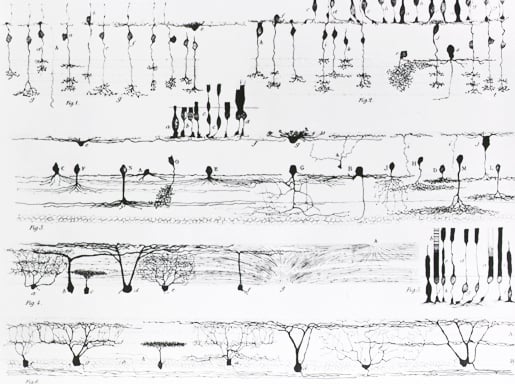Speed read: Exposing the Forest
The 1906 Nobel Prize in Physiology or Medicine was awarded to Camillo Golgi and Santiago Ramón y Cajal for revealing the inner beauty of the nervous system. By developing methods that could colour and highlight its key components, Golgi and Cajal allowed the anatomy of the nervous system to be observed and documented in precise detail.
When Camillo Golgi began studying the grey matter of the brain, existing techniques used to stain cells marked almost all parts of this dense tissue simultaneously, revealing no information about its finer details. Searching for a better staining method, Golgi experimented by candlelight in a hospital kitchen that he converted into a laboratory. There, he discovered a way of impregnating nervous tissue with a silver solution, which stained only a small number of nerve cells in black. This made it possible to view neurons in their entirety, from which Golgi could see the complex outlines and details of numerous branches with remarkable clarity.
Golgi’s silver staining method for nerves went unappreciated, until Ramón y Cajal enhanced its resolution and used this technique to investigate brains from young animals. Armed with a microscope, pen and paper, and endowed with artistic talent, Cajal created thousands of beautiful drawings depicting the intricate details of nervous tissue – which to him resembled a forest of outstretched trees. From his observations, Cajal developed the theory that the brain and spinal cord are made up of countless numbers of individual functional units, which his colleague Wilhelm von Waldeyer-Hartz later called neurons. According to this neuron doctrine, these individual cells have their own unique set of nerve processes, and the contents of each cell do not come into direct contact with that of other cells. Each neuron conveys its information to other cells through nerve fibres that extend across the space and barriers that separate them.
However, at the time the Nobel Prize was awarded, Golgi did not support the neuron theory for which Cajal had provided so much evidence – Golgi still interpreted the observations to indicate that the nervous system existed as a seamless continuous network, which forms an entirely distinct anatomical entity. Despite their difference in opinion, Golgi and Cajal became the first scientists to ever share a Medicine Prize.

Various types of nerve structures. Illustration by Cajal from the book Die Retina der Wirbelthiere, Tafel II.
Source: U.S National Library of Medicine, History of Medicine Division
Photographer unknown
Kindly provided by U.S National Library of Medicine
By Joachim Pietzsch, for Nobelprize.org
This Speed read is an element of the multimedia production “Nerve Signaling”. “Nerve Signaling” is a part of the AstraZeneca Nobel Medicine Initiative.
Nobel Prizes and laureates
Six prizes were awarded for achievements that have conferred the greatest benefit to humankind. The 12 laureates' work and discoveries range from proteins' structures and machine learning to fighting for a world free of nuclear weapons.
See them all presented here.
